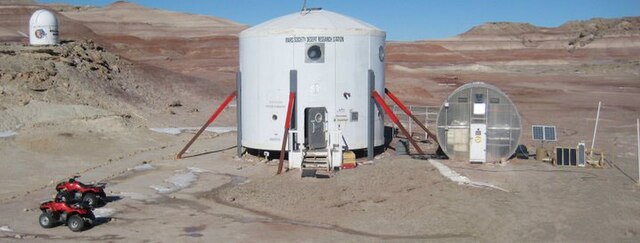A Mars analog habitat is one of several historical, existing or proposed research stations designed to simulate the physical and psychological environment of a Martian exploration mission. These habitats are used to study the equipment and techniques that will be used to analyze the surface of Mars during a future crewed mission, and the simulated isolation of the volunteer inhabitants allows scientists to study the medical and psychosocial effects of long-term space missions. They are often constructed in support of extensive Mars analogs. However, sometimes existing natural places are also valued as Mars analogs. Crewed Mars habitats are featured in most human Mars missions; an alternative may be terraforming or telepresence.
The FMARS hab in 2009
The Mars Society's Mars Desert Research Station
The BYU Mars Rover undergoing field tests at the Mars Desert Research Station.
The Mars Society is a nonprofit organization that advocates for human exploration and colonization of Mars. It was founded by Robert Zubrin in 1998 and its principles are based on Zubrin's Mars Direct philosophy, which aims to make human missions to Mars as feasible as possible. The Mars Society generates interest in the Mars program by garnering support from the public and through lobbying. Many current and former Mars Society members are influential in the wider spaceflight community, such as Buzz Aldrin and Elon Musk.
Musk giving details about Falcon 9 and Dragon spacecraft at the 2006 Mars Society convention
Mars Desert Research Station, with a central habitat, rover hangar, dome, greenhouse and an observatory.
A challenge in the University Rover Challenge where rovers have to pour fuel into a generator






